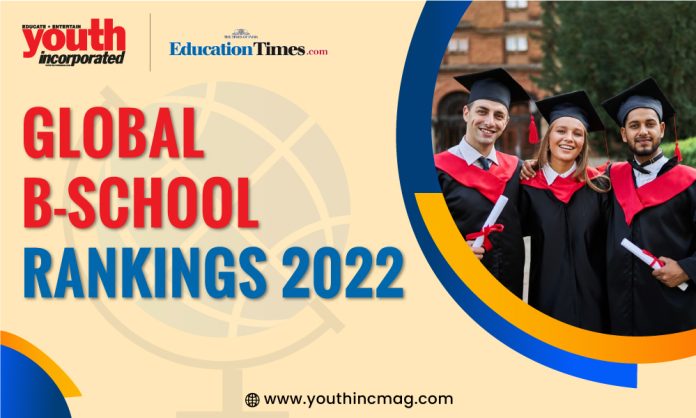What is entrepreneurship? Many say it’s creating business with ideas, or seeing opportunities and bringing about change, or creating something new of value with resources, for many it is leading people to success. There are many versions or concepts out there and majority of the youth of today are in favour of entrepreneurship. Young prodigies are proving how a simple business idea can truly change a life. When you watch live examples of this, you get motivated to push the pedal in the same direction. To be able to ride on the desired path of business and entrepreneurship, you need to have the right understanding, skills and of course, educational qualifications. India has the largest number of Startups and Unicorns today. We are going through the most transformational phase due to so much easy access to information, opportunities, mentorship, and hunger for people to do something for themselves and society. Just as the popularity of entrepreneurship is rising, so is the need for educational institutions offering quality teaching and learnings. Moreover, with the pandemic causing many companies to lay off their employees, more and more youth, fearing job insecurity, are inclining towards entrepreneurship.
If you are one of those who want to pursue a career in either Business, Finance, Marketing, Management or Economics; subjects that are most closely related to entrepreneurship, you need to pick out the best business schools for your professional growth and progress. To help our readers pick the correct business school for themselves, we at Youth Incorporated have come out with our annual Global B-School Rankings 2022 under which we have compiled the top 100 B-Schools across the globe which are best to graduate from.
Our team connected with 1820 institutes across the world and held discussions with students, recruiters, and the teaching faculty, to present to you the top 100 Global B-School Rankings. We also consulted professional organizations such as AMBA, EQUIS, and AACSB. Youth Incorporated’s Research Unit (YRU) also studied domestic rankings in various countries to find the best institutes.
The 2022 Business School Rankings haven’t seen many changes this year as compared to last year. Harvard University continues to remain at the topmost rank just like in 2021. Leaving its 6th position far behind, London Business School has occupied 2nd rank. Stanford University has slipped one step down coming back to the 3rd position for the second time after 2020 from 2021’s 2nd position. After falling down to the 6th rank in 2020 and then slipping down one more step in 2021 to the 7th rank, Columbia University now stands at 4th rank. INSEAD has been switching between 4th and 5th rank since 2020. In 2020 it was on the 5th position, moving one step ahead on the 4th position in 2021 and now going back down to the 5th position in 2022. Fighting its way back, IESE has gained the 6th position leaving behind its 19th rank of 2021 after being on the 10th rank in 2020. IE University has gained 7th rank in the list. MIT surprisingly has established a stronghold of the 8th rank since 2019 till now. From holding the 1st rank in 2020 to slipping one step down to the 2nd rank in 2021, the University of Pennsylvania has plunged down to the 9th rank in 2022. Cornell Univesity, however, after remaining in the 11th position for 2021 and 2020, has finally made its way into the top 10 global business schools.
Talking about the Indian picture, only two institutes have managed to secure a place in the top 20 category. IIM Ahemdabad has maintained its 16th rank like last year. IIM Calcutta too, has maintained its 18th rank from 2021. There are two more Indian institutes that have secured their ranks under the top 50 category apart from IIM Ahmedabad and IIM Calcutta. They include the Indian School of Business that has acquired the 25th rank, lower than the 23rd rank it held in 2021 and the SP Jain Institute of Management that has entered the top 50 list once again right at the edge securing the 48th position from the 52nd position in 2021. In a country that is laying great importance on startups and entrepreneurship, a total of only 4 Indian institutes have appeared in this year’s rankings which is quite disappointing. We can only hope this picture looks different and better in the next year.
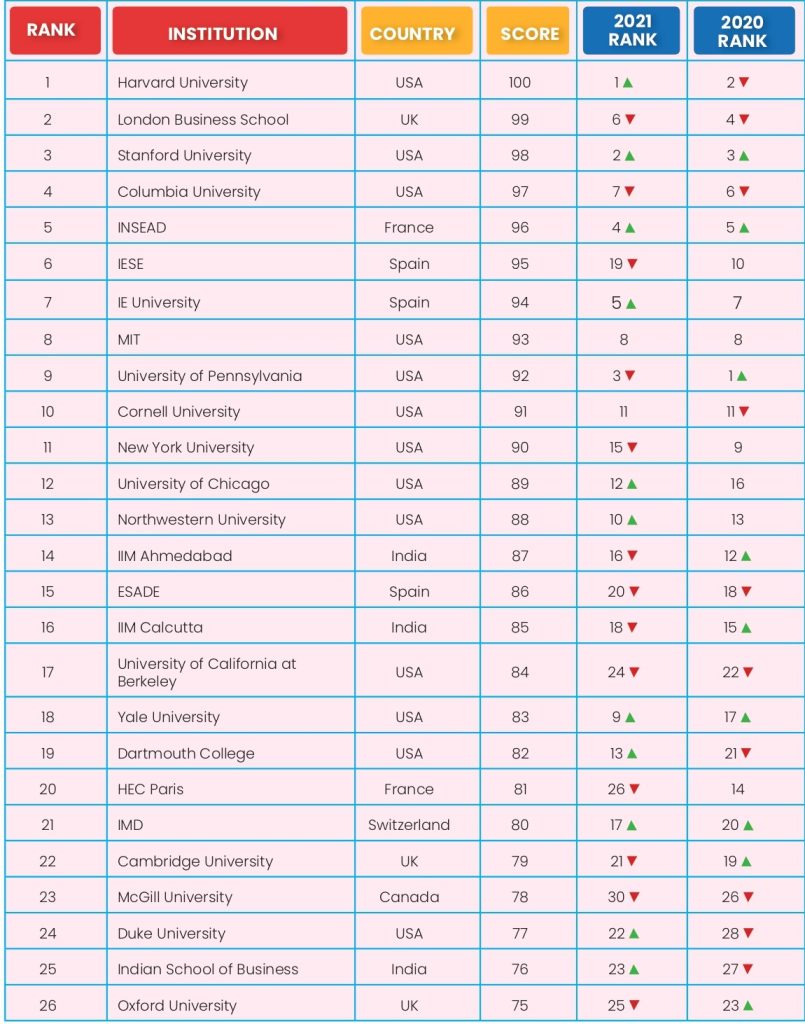
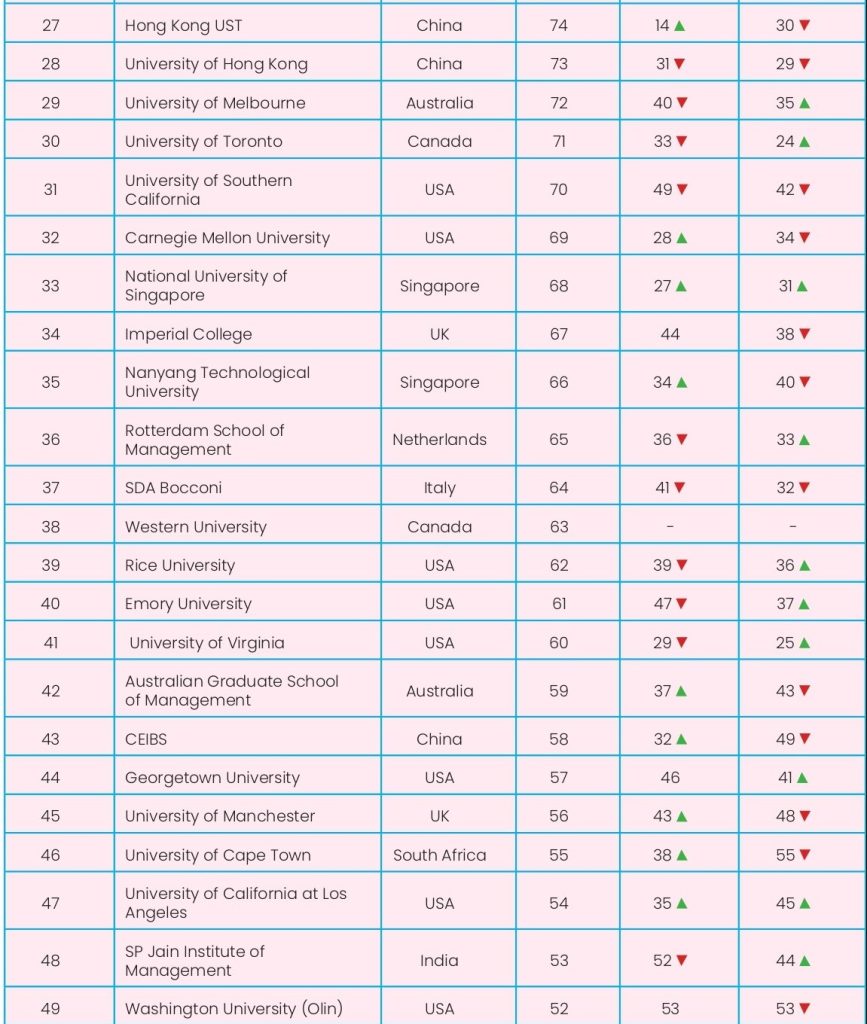
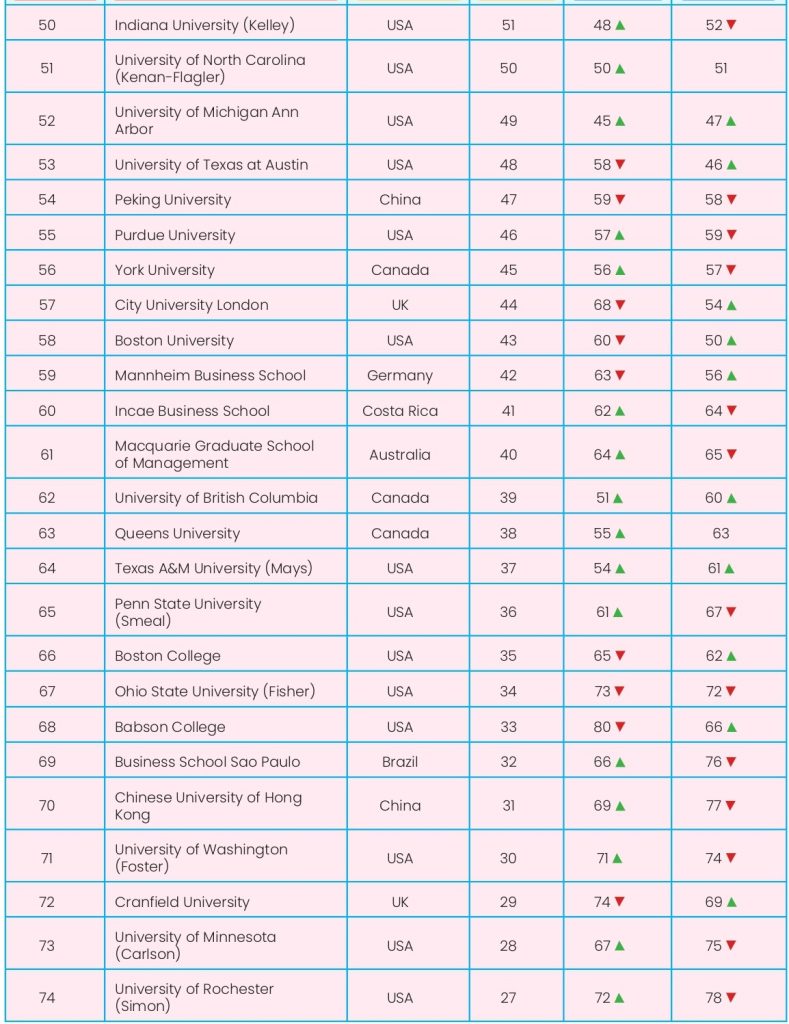
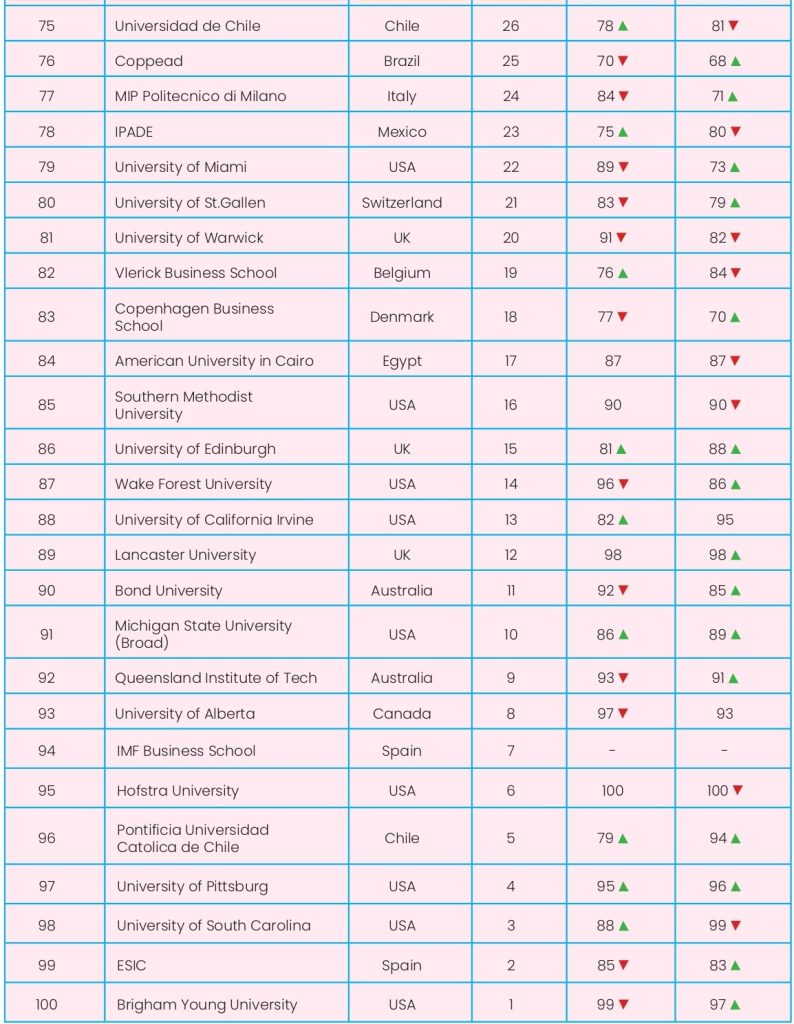
Ranking Methodology
How did we choose institutes?
We chose 1820 institutes across the world after having discussions with students, recruiters and faculty. We also consulted professional organizations such as AMBA, EQUIS and AACSB. Youth Inc’s Research Unit (YRU) also studied domestic rankings in various countries to find the best institutes.
All the institutes were sent identical surveys. We then contacted current students, alumni as well as local and international recruiters and gathered specific information about the institutes.
Factors considered
- Recruiter Perception – Identical surveys were sent to recruiters worldwide. The recruiters were asked to rate the institutes that they were most likely to recruit from. The recruiters were also asked to rate the students they have recruited from specific business schools on several criteria including leadership potential and strategic thinking.
- Diversity of Students – The institutes were asked to report the total number of students on campus and what percentage of the students were international and speak two or more languages. Gender diversity of the students was also considered.
- Diversity of Faculty – The institutes were asked to report the total number of faculty on campus and what percentage of the faculty was international, hold a doctorate degree and accredited with their own publishing material. Gender diversity of faculty was also considered.
- Innovation of Programs – We considered the different ways to construct degree programs as well as the choice students have in terms of selecting electives.
- Innovation in Teaching Methodologies – Institutes were asked to select different teaching methodologies that we considered innovative. Some of these included company visits, dual or multiple majors and course collaborations between different departments at the institute. Our list was selected after surveying students across different campuses worldwide.
- Value for Money – We considered students and alumni opinions on whether a particular institute was perceived as ‘value for money’. We also asked institutes to state the percentage of students who received some sort of funding from the institutes.
- Campus Support – We asked the institutes, current students and alumni to select the different types of assistance provided by the student office or a similar body on campus. Our list was selected after surveying students across different campuses worldwide.
- Career Service – We asked the institutes, current students and alumni about the availability and functioning of a career service cell and how active such a service was for the students. We also considered what percentage of students were actually placed through the institute’s career service cell, how long it look for such placements and what the average starting salaries were.
- Exchange Programs – Institutes were asked to report the percentage of students that opted for exchange programs. We also considered the exchange students present on the institute’s campus.
- Student Satisfaction – Current students and alumni were asked to rate their institutes on various factors including career services, attitude of staff and professors, location, and course content.
Actual Methodology
Institutes were provided a link using which they could send us their completed survey online. They were asked to answer questions relating to full time faculty, career service, student and program information and all the factors listed above.
We contacted current students and alumni of the institutes and asked them to rate specific statements which were pertaining to the factors we considered in this ranking. All the institutes preferred to send the survey links to their students and alumni directly.
Over 16200 recruiters were sent emails with a survey. The recruiter list was prepared from the responses of the institutes and also included internationally well known recruiters. The recruiters were asked to enlist institutes that they were likely to recruit from.
Below is a summary of the factors and the weight-age given to each factor when we ranked the institutes:
| Information reported by the institute | Information reported by current students | Information reported by alumni | |
| Diversity of Students | 2% | 2% | 2% |
| Diversity of Faculty | 2% | 2% | 2% |
| Innovation of Programs | 2% | 2% | 2% |
| Innovation in Teaching Methodologies | 2% | 2% | 2% |
| Value for Money | 2% | 2% | 2% |
| Campus Support | 2% | 2% | 2% |
| Career Service | 4% | 4% | 4% |
| Exchange Programs | 2% | 2% | 2% |
| Student Satisfaction | 2% | 2% | 2% |
| 20% | 20% | 20% |
| Information reported by recruiters | |
| Recall of institute where to recruit from | 10% |
| Likelihood of recruiting from same institute again | 10% |
| Overall satisfaction with students recruited | 10% |
| Satisfaction with institute career cell | 10% |
| 40% |
Each factor was made up of a set of questions. The total percentage attributed to that factor was based on the average score of the responses multiplied by the assigned weight-age. We then totalled the score from all factors and sorted the scores from highest to lowest. The institute with the highest score was ranked 1st.
Not just numbers!
After we received the total computed scores for the institutes, we subjectively analyzed the data provided by the institutes, current students, alumni and recruiters. If we found discrepancies in the satisfaction scores and the subjective descriptions, we omitted the data.
Institutes that did not fill out the survey reports in time
Out of the institutes that were contacted, 141 institutes did not complete the survey on time or did not respond. We used publicly available information on the institutes to include them in our ranking. We also contacted current students, alumni and recruiters of these institutes and compared the data we received with the data from institutes that did participate.
Special notes
Masters in Finance – The programs include the pre-experience as well as the post-experience Masters programs. The ranking also includes the programs which are recently established.
Masters in Management – Certain Masters of Management programs with specializations are also included in the ranking.
Masters in Marketing – Combination courses of Marketing with communication and other fields are also included in the ranking.
Online MBA – Certain factors such as Campus Support and Exchange Programs were omitted in the factors considered for the ranking.
Executive MBA – Certain factors such as Campus Support and Exchange Programs were omitted in the factors considered for the ranking.





















